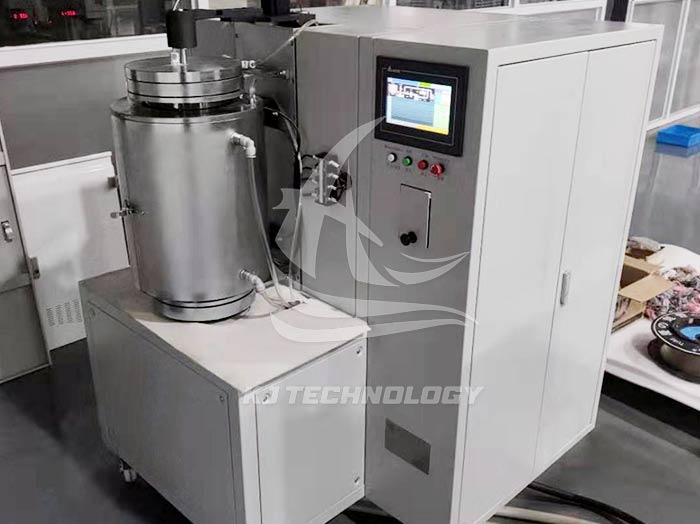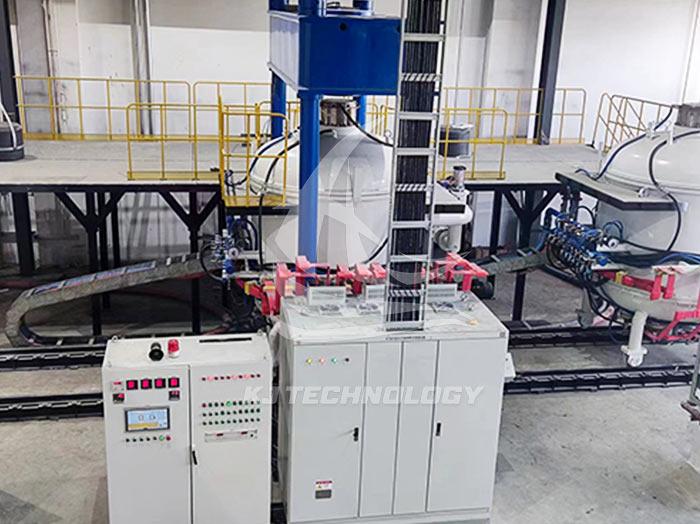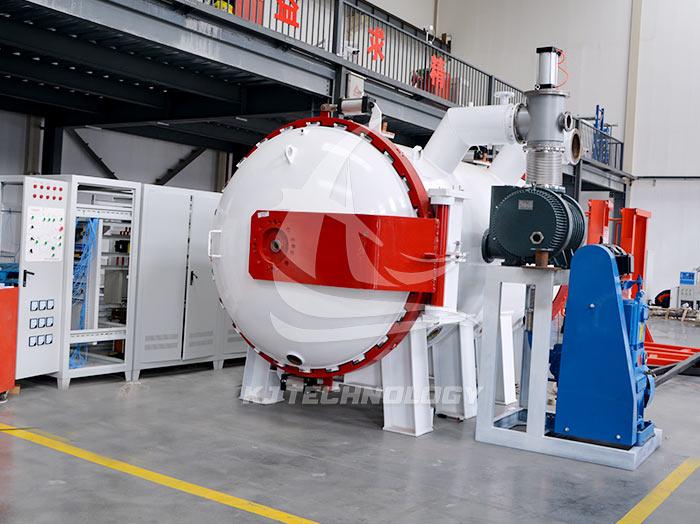Vertical vacuum hot pressing furnace sintering ceramics
 09-18-2025 Author: KJ technology
09-18-2025 Author: KJ technology
The vertical vacuum hot press furnace has significant advantages in sintering ceramics. Through the synergistic effect of high-temperature heating and pressure, combined with the vacuum environment, it can effectively improve the density, mechanical properties, and reliability of ceramic materials. The following is a detailed introduction:
1. Working principle and core advantages
Vacuum environment:
By using a vacuum pump to extract air from the furnace, a high vacuum or protective atmosphere (such as argon) is formed to prevent ceramic materials from reacting with oxygen, water vapor, etc. at high temperatures, reducing oxidation and volatilization losses, while promoting gas escape and reducing porosity.
High temperature heating and pressurization:
Heating system: using heating elements such as graphite tubes and molybdenum wires, with a maximum temperature of 2200-2400 ℃, to meet the sintering needs of advanced ceramics such as boron carbide and silicon nitride.
Pressure device: Apply pressure through a hydraulic system (usually adjustable from 5-30 tons) to promote particle bonding, eliminate pores, and achieve high densification. For example, when boron carbide is hot pressed and sintered at 2150 ℃ for 10 minutes, its relative density can reach 91.6%, which is much higher than the 80% -87% sintered at normal pressure.
Structural advantages:
Vertical design: Under the action of gravity, the pressure distribution is uniform, reducing workpiece deformation, and suitable for sintering large-sized or complex shaped ceramics.
Integrated structure: integrating vacuum system, heating device and pressure mechanism, easy to operate, and low maintenance cost.
2. Key technical parameters of sintered ceramics
Temperature control:
Maximum temperature: 2200-2400 ℃ (some models can reach 2500 ℃).
Temperature uniformity: within ± 5 ℃, ensuring consistency in material properties.
Temperature control method: PID self-tuning function, supports programmable automatic control, with an accuracy of ± 1 ℃.
Vacuum degree:
Ultimate vacuum degree: ≤ 5 × 10 ⁻ ³ Pa, effectively eliminating gas residues and improving product density.
Working vacuum degree: usually ≤ 1 × 10 ⁻ ² Pa, meeting most ceramic sintering requirements.
Pressure system:
Pressure range: adjustable from 5-30 tons, accuracy ± 0.01MPa, supports manual or automatic pressurization.
Pressure head design: diameter 150mm (customizable), made of graphite or high-strength alloy material, resistant to high temperature and high pressure.
Cooling system:
Rapid cooling: By using water cooling or helium cooling, the production cycle can be shortened.
Cooling speed: It can be filled with protective gas (such as nitrogen) to accelerate cooling and prevent cracking.
3. Typical application cases
Boron carbide ceramics:
Challenge: Boron carbide has a high proportion of covalent bonds (93.94%), low diffusion coefficient, and is difficult to sinter at normal pressure, resulting in densification.
Solution: Adopting a vertical vacuum hot press furnace, sintering under pressure at 2150 ℃ for 10 minutes, resulting in higher relative density and reduced thermal conductivity, meeting the needs of bulletproof armor, wear-resistant components, and more.
Functional ceramics:
Application: Sintering ceramics such as zirconia and silicon nitride, used for electronic ceramic substrates, ceramic bearings, bioceramics, etc.
Advantages: The vacuum environment suppresses abnormal grain growth, enhances material strength and toughness.
Ceramic metal composite materials:
Application: Preparation of ceramic armor, cutting tools, etc.
Process: Solid bonding between ceramics and metals is achieved through hot pressing sintering, with high joint strength and high temperature corrosion resistance.
4. Equipment selection suggestions
Temperature and pressure requirements:
Select the appropriate temperature range and pressure parameters based on the type of ceramic material (such as oxide, carbide, nitride).
For example, sintering boron carbide requires a high temperature of over 2200 ℃ and a pressure of 20-30 tons.
Vacuum system configuration:
Prioritize the combination of mechanical pump+diffusion pump or molecular pump to ensure that the ultimate vacuum degree is ≤ 5 × 10 ⁻ ³ Pa.
Configure vacuum tubes, pneumatic high vacuum butterfly valves, etc. to improve system sealing.
Heating element and insulation material:
Heating element: Graphite tube is suitable for high temperature scenarios, while molybdenum wire is suitable for medium and low temperature scenarios.
Thermal insulation material: using multi-layer graphite felt or ceramic fibers to reduce heat loss and improve temperature uniformity.
Automation and Security:
Control system: Supports PLC touch screen operation and has interlock alarm functions for over temperature, over pressure, and water pressure.
Safety design: equipped with sound and light alarm, emergency stop button to ensure safe operation.








